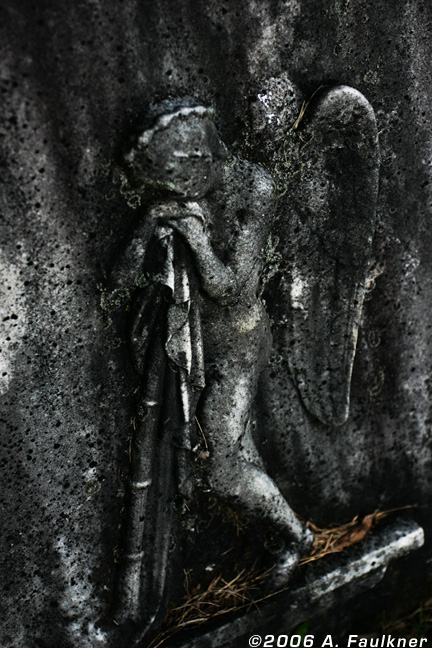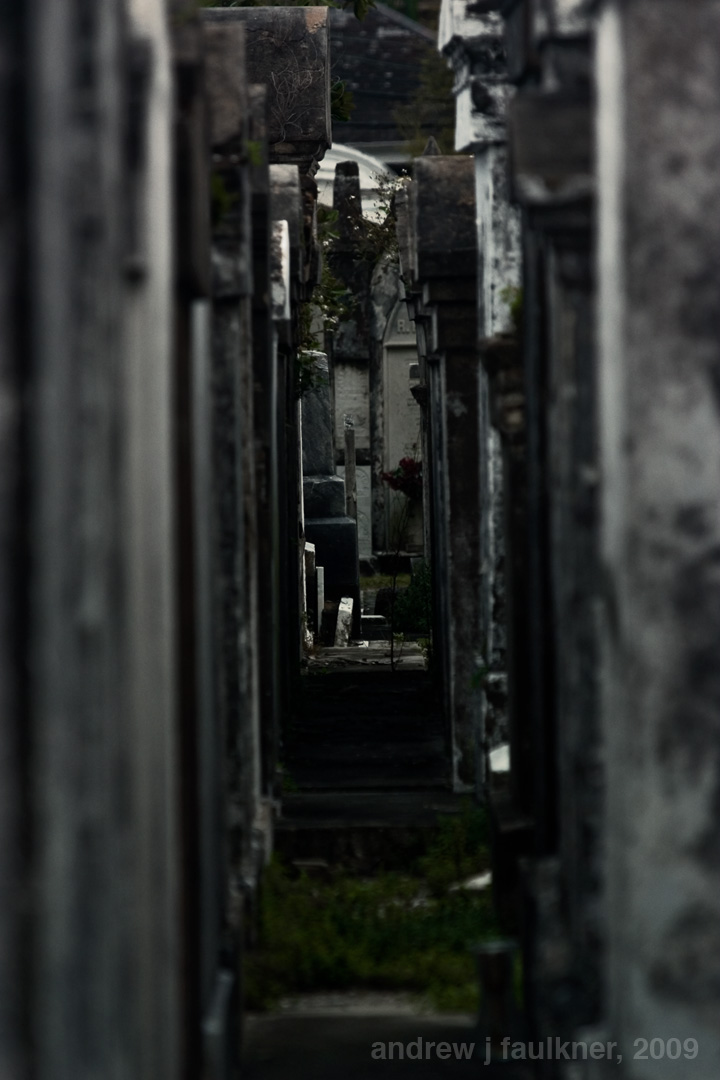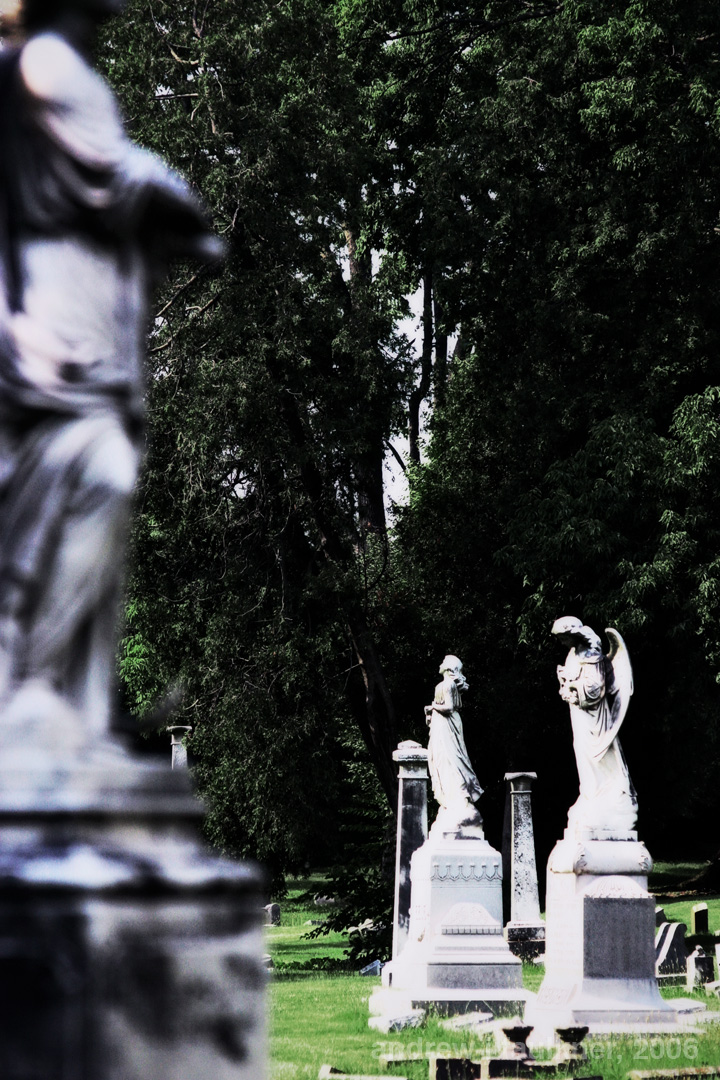No earthly state stands less fickle,
As with the wind that waves the wicker,
So waves this world's vanity--
Fear of death unsettles me.
...
Unto the Death go god's estates,
Princes, lawyers, Heads of state,
Both rich and poor in all degrees--
Fear of death unsettles me.
--Joe Scanlan, "Lament for the Makers"
 Headstone at Greenlawn Cemetary, Columbus, Ohio.
Headstone at Greenlawn Cemetary, Columbus, Ohio. This is the first part of a three part series that will focus on cultural/spatial responses toward death, the tenuous position that cemetery ritual has in modern culture, and a radical rethinking of burial practice as sustainable infrastructure.
Part One: The Emergence of the Cemetery
Burial grounds stand in cities throughout the world as memento mori or monuments reminding us of our own mortality. Intensely loaded with religious symbology and cultural allegory through their design, these places often represent the values of a culture most clearly. Originally intended as places of mystic ritual, burial grounds are the spatial reification of humanity’s struggle with that which lies beyond understanding.
Before the modern area burial grounds served as an anchor of community. People were born, families were created and members died within eyesight of their place of worship. In the western world the church graveyard served as an extension of the home. The church graveyard was so expropriated by its living constituents that “the church finally had to forbid such activities as gambling and dancing within cemeteries”1.
That such an idea seems alien to the modern observer is a result of the massive cultural shift in the modern age. In the seventeenth and eighteenth century numerous church graveyards had begun to give way towards organized cemeteries in many European cities. These early cemeteries were orderly necropoli containing a grid of small mausoleums where the dead were interred in an urban environment resembling that in which they lived their lives. Such cemeteries are rare in this country. The best examples can be found in New Orleans, which as a far outpost of France did not witness the post-revolutionary cultural change that the motherland did.
 Lafayette Cemetery Number One, New Orleans, Louisiana.
Lafayette Cemetery Number One, New Orleans, Louisiana. After the French Revolution, the strict rectilinear order with elite districts of ostentatious interment was believed to represent the ancien regime. Those that laid out new cemeteries sought a more egalitarian design and looked to the culture of rural laborers for a new order. As this type of cemetery was built in England and the United States, this practice coalesced into a structured reinterpretation of a pastoral landscape. While such cemeteries strive to seem untouched idylls they harnessed the very latest engineering and hydraulic innovation to reshape the landscape.
As a result of their bucolic appearance cemeteries assumed the public life that once characterized the church yard. In the high Victorian area cemeteries, like asylums, were not seen as places of difference, but rather served as needed islands of nature in industrial cities. It was common for families to travel to the cemetery or asylum grounds for weekend picnics or recreation. Such practices led to efforts to create publicly accessible parks. Despite their popularity, cemeteries still were redolent of human mortality, and, as the nineteenth century ended, parks displaced cemeteries as grounds for recreation.
 The idyll of death: landscape at Greenlawn Cemetary, Columbus Ohio.
The idyll of death: landscape at Greenlawn Cemetary, Columbus Ohio. While cemeteries were seen primarily as places of recreation that would provide religious and moral instruction in Victorian times, these sentiments have become incompatible with modern lifestyles. "There is no available ideology to integrate them comfortably into the rhythms of the metropolis."2 Cemeteries have again changed to reflect current culture. While burial once emphasized the deceased’s ties to kin with demarcated family plots, ornamental fencing, common design, and often communal monuments, modern monuments seem designed to accentuate the individual. The landscape has become an unsuccessful hybrid of the idyllic and the Euclidean with a gridded aggrandizement of individuality overlaid over an impotent derivation of a depoliticized peasant landscape. Furthermore, the loss of the cemetery as communal space has also led to the relegation of the dead to the margins of society.
In the premodern area, through shared ritual and spatial proximity the dead were allowed to exist within society. Today, disease is viewed from the lens of unproductivity, and death is the anthesis of the productive life that defines success. Our culture banishes death to the margins and refuses to contemplate its meaning, for “In a society that officially recognizes ‘rest’ only in the forms of inertia and waste, death is given over for example. to religious languages that are no longer current, returned to rites that are now empty of the beliefs that once resided in them”3. Today cemeteries exist as dualistic monuments: monuments to the desire of eternal memory in the face of death and monuments to the practices and customs of our ancestors.
 Modern headstones contrast with empty attempts at romantic landscapes, Laurel Hill Cemetery St. Louis.
Modern headstones contrast with empty attempts at romantic landscapes, Laurel Hill Cemetery St. Louis. Works Cited in this Article:
1 Kearl, Michael C. Endings: a Sociology of Death and Dying. New York: Oxford University Press, 1989. p. 50. 2
2. City A-Z. Ed. Steve Pile and Nigel Thrift. New York: Routledge, 2000. p. 92.
3 De Certeau, Michel. The Practice of Everyday Life. Berkeley: University of California Press, 1988. p. 192
Coming Soon: Part 2: The Psycho-spatial disconnect of Modern Cemeteries







0 reactions:
Post a Comment